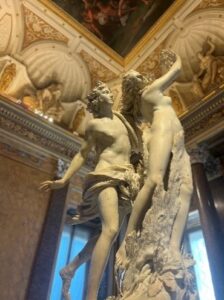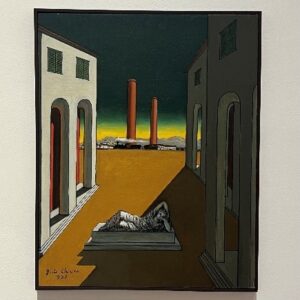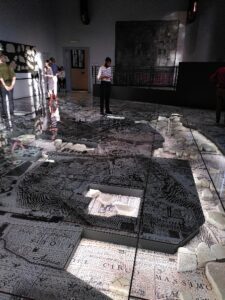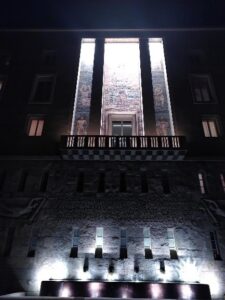A Student’s Perspective on a Workshop at the KNIR: Reception History and Colonialism (22-24 October 2024). By Caroline Murphy.
Scholars convened at the KNIR in Rome for the Reception History and Colonialism workshop between October 21-25. The workshop is part of the broader Settler Colonial Paradigms (SECOPS) research project and provided a rich exploration of how classical texts and colonial ideologies intersect. During this workshop, scholars of various expertise in ancient history and the reception of antiquity in later periods were brought together to delve into how historical texts have been repurposed in various contexts to justify colonial and imperial ambitions. They each brought unique perspectives and impulses to the table which prompted nuanced discussions over the course of the three days.
Ancient paradigms of knowledge have had an enduring influence throughout history. This workshop aimed at understanding the multifaceted nature of the phenomenon of classical reception history. In light of the recent emergence of postcolonial studies, it is crucial to learn how classical knowledge and legacies shaped colonial ideologies and practices – though much is left to be said if we are to move to greater equality in global politics. Taking a social constructivist perspective on colonialism, by focussing on the many aspects of society which maintained colonial power structures, invites deconstruction and novel ways of understanding the underlying classical influences which drove colonisation, and therefore also how classical knowledge shaped the world of today.
We began the workshop with a rich analysis of the Corpus Agrimensorum Romanorum presented by Anouk Vermeulen, revealing how Roman land surveyor texts encoded and perpetuated imperialist discourse. Ivo Wolsing followed with a study of Crusader colonialism, examining the medieval author William of Tyre’s classical and biblical interpretations to construct a Christian identity in the Middle East. Towards the end of the day the group visited the Forma Urbis Romae – an ancient marble map of Rome – which I found to be particularly fitting following Anouk Vermeulen’s presentation on the Corpus Agrimensorum in that it continued the theme of spatial organisation as a means of imperial control.
On subsequent days, Dinah Wouters and Arthur Weststeijn analysed two of Caspar Barlaeus’s poems, which reflected a moral ambivalence on Dutch colonial conquests, contrasting the promise of wealth with the societal costs. They were followed by Tycho Maas, who explored Virgil’s Aeneid in the context of African colonial discourse. Teddy Delwiche uncovered indigenous narratives of classical education in colonial New England, highlighting Native American agency in the formation of colonial educational systems. The day was concluded by Sam Agmabu’s Research dialogue, which highlighted how Petrarch’s Africa influenced Fascist Italy, a legacy still visible in Rome’s cultural and architectural fabric.
On the final day, Matthijs den Dulk presented discussions of Paul’s Letter to the Galatians – and explained how these were misused in the Victorian era to justify British imperialism. Us students were then given the opportunity to present our own essay topics, which for me proved to be invaluable experience in presenting my own research to a group of scholars and respond to questions, comments and any critiques. My topic concerned the idealisation of Greek body art and the spread of British sports in the Colonies. A special thanks to Sam Agmabu, who shared his forthcoming paper on the Trinidadian CLR James and his colonial education. Finally, Sam Agmabu concluded the workshop with his exploration of Petrarch’s Africa as an ideological bridge between Roman and modern Italian imperialism.
The time I spent at KNIR was immensely valuable for me as a young student. It gave me the opportunity to have more informal conversations with scholars who were years ahead of me, which gave me useful insight on interesting research projects and the possibilities available within academia. The KNIR is an amazing place for scholars of all levels to connect and exchange ideas.
I was never lacking in information about sights to visit during my time off. I chose to visit the Galleria Borghese (see pictured, Apollo and Daphne’s Statue), the National Gallery of Modern Art (see Piazza d’Italia by Chirico), the Colosseum and Forum Romanum, just to name a few. Having the workshop in Rome was fundamental to forming an impression of the sheer scale as well as cultural and historical significance of Rome.
A Student’s Perspective on a Workshop at the KNIR: Reception History and Colonialism (22-24 October 2024). By Sanne Rutterkamp.
For centuries, settler communities have occupied new territories and exercised their authority over a multiplicity of people. The field of settler colonial studies researches the paradigms that characterize these regimes and asks what makes them different from other colonial models. The SECOPS project aims to explore the deep historical roots of settler colonial paradigms in antiquity and postclassical contexts. The workshop focused on reception history and colonialism and aimed to discover how classical paradigms influenced historical practices of colonialism and were used to guide and legitimize them. The workshop provided a platform for interdisciplinary discussions and the creation of new academic networks over the course of three days. The planning allowed enough time for discussion; every presentation was followed by a discussion of at least half an hour, which gave participants enough time to think about and comprehend what was explained, make connections to their own research, and offer comments.
The workshop created an open and stimulating intellectual climate for the participants to share their diverse topics of research and discuss each other’s work. The diversity and multidisciplinary atmosphere enabled us to look at settler colonialism through a multiplicity of case studies in world history, which led to the discovery of unexpected similarities. First, we focused on the role of landscapes through the Corpus Agrimensorum Romanorum, a collection of texts on land division. The division of space is strongly connected to the division of power, which is illustrated in the Forma Urbis museum we visited. Recovered parts of the marble map of ancient Rome, engraved under Emperor Septimus Severus, are on display here. Second, the role of religion, although always present in the background, was especially prevalent in our discussion of Paul’s letter to the Galatians and the medieval author William of Tyre’s book on the history of the Crusader States. Both of these works resort to classical sources and inspired imperialist efforts. Similarly, classical education in colonial New England served to Christianize the Native American community by installing Native American ministers, which we explored through the case of John Mettawan. Third, seventeenth-century Latin poems by Barlaeus and a Latin letter by the colonial administrator Grevenbroek showcase a high level of intertextuality with multiple classical sources, which are used to both glorify and criticize colonial efforts. It was interesting to see that both texts, as others we discussed during the workshop, tend to resort to the same classical sources. Especially popular throughout history is Virgil’s Aeneid and the example of Carthage, often used as a model for a new settlement.
On Wednesday, the day was concluded by a KNIR Research Dialogue on Petrarch’s Africa, the Punic Wars, and the epics of empire, such as the Aeneid and the Odyssey. This Research Dialogue was accessible for everyone, which broadened the discussion and allowed for new perspectives. Petrarch’s Africa was used as a source of inspiration in fascist Italy, which is still visible in Rome today.
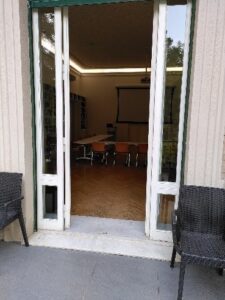 In this workshop, we had the opportunity to present our own research ideas for a paper on problematic classical heritage. My research topic was the use of the Masada mythical narrative employed by the State of Israel to legitimize their settler colonial status. This was an amazing chance to experience what it is like to present our own research in front of a group of experts and to improve our own work through their feedback. I personally learned a lot about what a career in research can look like, through conversations with both the other participants in the workshop and also the other guests and students at the KNIR, many of which are currently working on a PhD. The informal and academic atmosphere of the workshop enabled us to get to know each other through shared dinners, excursions, and discussions. The stay at the KNIR was a unique and enriching experience; it allowed for interesting conversations about current research, education, and possible job prospects.
In this workshop, we had the opportunity to present our own research ideas for a paper on problematic classical heritage. My research topic was the use of the Masada mythical narrative employed by the State of Israel to legitimize their settler colonial status. This was an amazing chance to experience what it is like to present our own research in front of a group of experts and to improve our own work through their feedback. I personally learned a lot about what a career in research can look like, through conversations with both the other participants in the workshop and also the other guests and students at the KNIR, many of which are currently working on a PhD. The informal and academic atmosphere of the workshop enabled us to get to know each other through shared dinners, excursions, and discussions. The stay at the KNIR was a unique and enriching experience; it allowed for interesting conversations about current research, education, and possible job prospects.
After the workshop, a literature list was created to share relevant articles and books. Participants also expressed their enthusiasm in continuing to have regular meetings. This shows that the discussions and conversations during the workshop have been fruitful and productive and planted the seeds for future collaborations and research.
